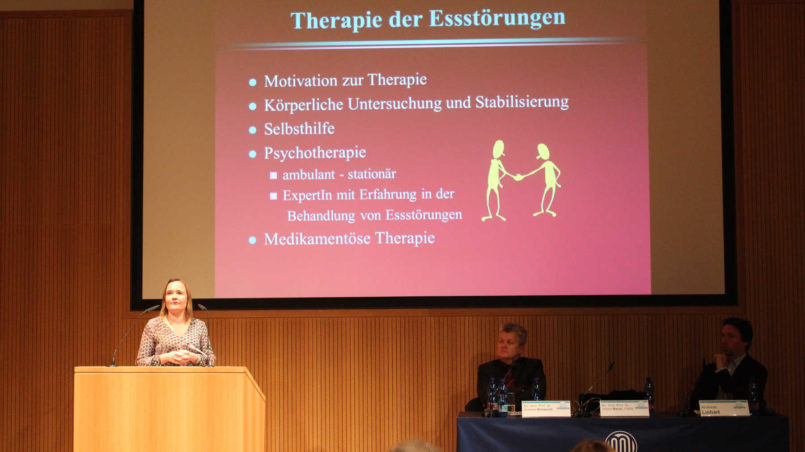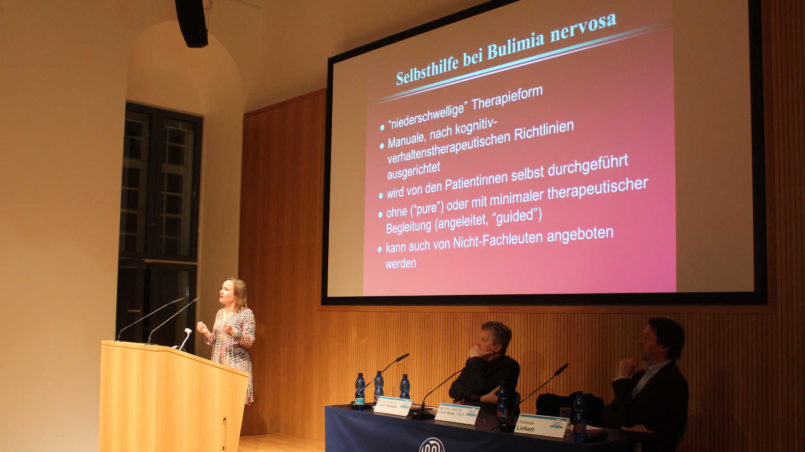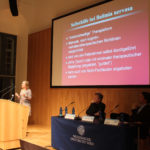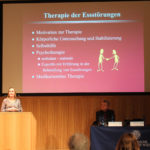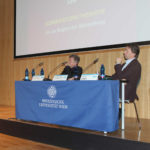Bulimia Nervosa and Binge Eating Disorder

Event data
- Datum
- 21. 2. 2017
- Host
- Mini-Med Studium
- Location
- Van-Swieten-Saal der Medizinischen Universität Wien
- Event-type
- Vortrag
- Participants
- Ao. Univ.-Prof. Dr. Ursula Bailer, FAED, Univ.-Klinik für Psychiatrie und Psychotherapie, Leitung der Ambulanz für Essstörungen, AKH Wien
On the evening of February 22nd 2017, Prof. Ursula Bailer held the second part of the event with the title „Too little and too much – do we have a disturbed relationship to food?“ in the Van-Swieten Saal of the Medical University of Vienna. As head of the out-patient clinic for eating disorders of the Vienna General Hospital (since 2001), she focuses on eating disorders where “too much” food is consumed, in particular, therefore, bulimia nervosa and the binge eating disorder.
She started her lecture by pointing out that also these disorders, in most cases, begin with a diet or over-rigid eating behaviour, although with both disorders an excessive food intake is in the foreground.
In this context she refers to the possibly personal experience that, when a diet is started, thoughts start to circle around food very strongly or that an excessive preoccupation with food arises.
Subsequently this, not only psychopathological but also clinical pathology leads to a loss of control in everyday life; binge eating can become a consequence, i.e. in a very short period of time a huge amount of food is consumed.
Being on a diet per se can also lead to a very selective food intake, such as the special cutting of food as well as a specific unusual combination of food (for example, sweet and sour). Further consequences of being on a diet are depressiveness, irritability and, after a longer period, social withdrawal, isolation and impairment of school or employment performance.
As such, being on a diat does not only affect one person – it is possible that there are also changes in the family structure, potential secondary gains for the patients and also those changes, already mentioned in the first part, in the neuronal regulatory structures due to nutritional limitations.
Bulimia nervosa
Similar to the “purging type” sub-type with patients suffering from anorexia, where binge eating also occurs, patients suffering from bulimia try to counteract weight gain through such attacks.
The excessive, compulsive practising of sports, with the intention of burning the consumed calories, is also very common (see the criteria of bulimia nervosa according to the American Diagnosis Manual). A further feature are patients who not only suffer from diabetes mellitus, but also from an eating disorder, who often lose weight as a result of the practice of so-called “insulin purging” (intentional insulin omission). An appropriate attitude or treatment of diabetes is hardly possible with these patients.
The criteria of bulimia nervosa, according to the American Diagnosis Manual (DSM-IV)
- Recurrent episodes of binge eating. An episode of binge eating is characterized by both of the following: eating, in a discrete period of time (e.g., within any two-hour period), an amount of food that is definitely larger than most people would eat during a similar period of time and under similar circumstances. A sense of lack of control over eating during the episode (e.g., a feeling that one cannot stop eating or control what or how much one is eating).
- Recurrent inappropriate compensatory behavior in order to prevent weight gain, such as self-induced vomiting, misuse of laxatives, diuretics, enemas, or other medications; fasting, or excessive exercise.
- The binge eating and inappropriate compensatory behaviors occur, on average, at least twice a week for three months.
- Self-evaluation is unduly influenced by body shape and weight.
- The disturbance does not occur exclusively during episodes of anorexia nervosa (in this case it concerns the anorexia nervosa: bulimic type)
Indirect indications
Whilst anorexia nervosa can be diagnosed visually, bulimia is often not recognised. Prof. Bailer states that she herself is always astonished how often and how long patients suffering from bulima can hide it from their families. The patients often need a long time to overcome their feeling of shame and to seek help.
There are more often indirect indications for bulimia. These include hypertrophy (swelling) of the salivary glands (parotide gland), which can lead to a mumps-like appearance. Dentists commonly raise suspicions as they find tooth damage (enamel defects, the development of caries, a loosening of fillings) due to the sour contents of the stomach. Often anguar cheilitis (tears in the corner of the mouth) and a callus formation on the index finger (due to contact of the incisors with the finger when triggering the gag reflex, also called “Russel sign”) are evident. Depending on the experience with vomiting, petechiae (author’s comment: punctiform haemorrhages) can appear on different parts of the body.
Binge eating disorder (disorders with eating attacks)
The binge eating disorder is also characteristised by extreme eating attacks, which are accompanied by great psychological stress on the part of patients. Similar to bulimia nervosa, these attacks often occur secretly and alone. Those affected very often feel shame due to this behaviour.
After an eating attack, patients are disgusted with themselves, depressed and feel very guilty. Patients suffer massively from the binge eating disorder.
Definition of the binge eating disorder according to the American Diagnosis Manual (DSM-IV)
- Recurrent episodes of binge eating. An episode is characterized by:
- Eating a larger amount of food than normal during a short period of time (within any two-hour period).
- Lack of control over eating during the binge episode (i.e. the feeling that one cannot stop eating).
- Binge eating episodes are associated with three or more of the following:
- Eating much more rapidly than normal.
- Eating until feeling uncomfortably full.
- Eating large amounts of food when not physically hungry.
- Eating alone because you are embarrassed by how much you’re eating.
- Feeling disgusted, depressed, or guilty after overeating.
- Marked distress regarding binge eating is present.
- Binge eating occurs, on average, at least two days a week for six months.
- Binge eating is not associated with the regular use of inappropriate compensatory behaviour, i.e. fasting
- Substance abuse (laxatives or diuretics).
- Excessive exercise.
- Binge eating does not occur exclusively during the course of:
- Anorexia nervosa
- Bulimia nervosa
Frequency of bulimia and the binge eating disorder
The point prevelance (frequency at a certain time) lies at approx. 1%, while 90-95% of patients are female. Subsyndromal characteristics (in this case all symptoms of the disorder are not present) occur more frequently; Prof. Bailer speaks of a prevalence of up to 20%. Dieting as a risk factor for the development of an eating disorder is particularly widespread among female secondary school pupils and often occurs as a group activity.
Within the scope of weight loss programmes, there is, however, often a number of people with a binge eating disorder. According to Prof. Bailer, it is important here to regognise and diagnose the illness. Also among patients who undergo bariatric surgery (overweight surgery) is the binge eating disorder widespread.
Prognosis and development of bulimia and the binge eating disorder
Bulimia is an illness, which, although responding well to therapy, has a very high relapse rate. In the truest sense of the word it is a waiting game with many years of support for the patient, in which relapse prevention is particularly important. Patients especially have to be taught how to recognise and prevent appropriate behaviour early.
The binge eating disorder, where obesity is a prognostic problem, could also lead to the metabolic syndrome (consists of diabetes mellitus, hypertension, and hyperlipidemia). Furthermore, this illness tends to become chronic and unfortunately also to relapses. Many patients only seek help as a consequence of the weight gain as a result of the illness, instead of already within the scope of the eating attacks.
Comborbidities (associated disorders)
In particular with bulimia nervosa, but also with the binge eating disorder, many other psychiatric illnesses often appear. Only very seldom is a person affected by one of the eating disorders in isolation. In the case of such a disorder, the clinician’s responsibilities always include a fast and thorough explanation of potential further suffering.
Causes of eating disorders
As already mentioned in the first part of the talk, these are disorders with a multi-factor genesis, which cannot only be due to the contemporary ideal of beauty. Similar to anorexia, bulimia has also existed for a significantly longer period of time and since a period when the ideal was represented by a completely different type of body. The factors (genetic, neurobiology, psychotherapeutic theories) are substaintially more complicated than often assumed, and furthermore also interact with each other.
Risk factors for bulimia and the binge eating disorder
Therapy in the case of bulimia and binge eating disorder
Although bulimics and patients with binge eating disorders often experience great psychological stress, their ideas as regards therapy are often not compatible with those of clinicians. In many cases, there is only a desire to reduce/eliminate the eating attacks and many patients do not strive for regular eating behaviour.
Establishing the right motivation and insight with patients can often take time (keyword: waiting game)
Within bulimia, the frequent vomiting can lead to numerous subsequent complications, for example, electrolyte imbalance (change of the body salts), which require appropriate treatment.
Self-help is of great significance in the treatment of this eating disorder as a first step of therapy. Sometimes this is the only help which is necessary for patients.
It is also important that the therapy is carried out by properly trained people with expertise in eating disorders. In practice this is often not the case. Therapy with medication is of great significance for these eating disorders.
Especially with bulimia, a tiered programme has been proven to be particularly helpful. In the first place, there are self-help programmes in book form as well as psychoeducation for the individual concerned as well as their family. Self-help is conducted personally by patients but can also be guided. Non-experts can offer this.
In particular, anti-depressants can be administered, above all selective serotonin reuptake inhibitors as these also have an appetite-regulating function and an anti-bulimic effect. With this medication, it is possible to reduce the number of eating attacks but they should, however, be taken over a longer period of time and under no circumstance should they be discontinued suddenly.
For the binge eating disorder, there is also a self-help programme in book form. In the case of this disorder, cognitive behavioural therapy has proven to be particularly effective.
Possible therapy with medication in the case of the binge eating disorder also includes selective serotonin uptake inhibitors (anti-depressants) as well as anticonvulsant drugs (author’s note: anti-convulsant drugs are used for epilepsy). A successful reduction of eating attacks is often possible by means of a combination of psychotherapy and medication. Patients with this disorder are, however, unfortunately also apt to relapse.
The interest on this topic was evident from the almost full Van-Swieten-Saal. The experts were available for questions after the lecture and the audience made good use of this possibility. Both speakers succeeded in conveying specialist, complex information in a manner which was understandable.

